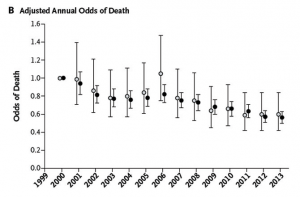
Explore This Issue
ACEP Now: Vol 34 – No 05 – May 2015(click for larger image)
Figure 3.
Image Credit: The New England Journal of Medicine ©2015.
image did what all good #FOAMed (free open access medical education) should do: it inspired me to read a new primary literature paper that I otherwise would not have.
One of my own attendings at Mount Sinai Hospital in New York and Twitter newbie Amy Leuthauser, MD (@AmyLeuthauser), has vowed to “win” Twitter. So far, it’s working. Her tweet is a picture that she took in the London Underground of an ad from the United Kingdom’s National Health Service (NHS) designed to decrease unnecessary emergency department visits (see Figure 4), and it sparked quite the #FOAMed debate. The NHS sign discourages patients from using EDs for nonemergencies. The question is: is that a good strategy, or does it put the blame on
patients instead of a bloated, outpatient system? That important debate played out on BoringEM, a blog by Brent Thoma, MD, emergency medicine resident at the University of Saskatchewan in Saskatoon, Canada, thanks to an excellent post he wrote on the topic. It garnered many insightful comments by several #FOAMites, including Dr. Seth Trueger (@MDaware), Dr. Damian Roland (@Damian_Roland), EM physician assistant Patrick Bafuma (@EMinFocus), Dr. Nadim Lalani (@ERMentor), medical student Gerhard Dashi (@GerhardDashi), Dr. Rajiv Thavanathan (@rajivthala), me, and others. These top-notch, informed, nuanced, and varying opinions all stemmed from a tweet and a blog.
Finally, in the wake of Leonard Nimoy’s death, medical student and #FOAMed

Figure 5.
wunderkind, the future doctor Aidan Baron (@aLittleMedic), a student in Sydney, Australia, tweeted this image that should help you remember the dermatomal distribution of the brachial plexus once and for all (see Figure 5). In his tweet, Mr. Baron thanked whoever anonymously created this inspired image, but in turn, I thank him for bringing it to my Twitter feed. Live long and prosper, my friends, and may your brachial plexi be intact.
Reference
Pages: 1 2 | Single Page






No Responses to “Medical Education Images on Twitter Have Potential to Go Viral”